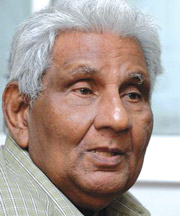Current trends show promise
 Contemporary Lankan writing in Tamil is encouraging. New writers have
come to the fore, although most of them need to understand and practice
more on the craft of writing. Contemporary Lankan writing in Tamil is encouraging. New writers have
come to the fore, although most of them need to understand and practice
more on the craft of writing.
Some of the senior writers continue to write a few noteworthy
fictions (novels, short novels, short stories, allegories, poems
etcetera) with a little more care for the structure for their writing.
Since the late 1950s, Lankan writers in Tamil began to be conscious of
their own individuality of a Lankan consciousness as opposed to identify
blindly the identities that are inherent to those writing in Tamil
across the Palk Straits.
This social and cultural consciousness did not arise as a natural
process but as a result of a drive propagated by a few progressive
intellectuals with Marxist leanings. Chief among them were two leading
intellectuals of the county – academics the late K Kailasapathy and the
late K Sivathamby.

K Sivathamby |

K Kailasapathy |
What they emphasized were social consciousness, regional flavour in
writing (meaning the use of dialects peculiar to regions where Tamil was
the predominant language) and focusing ion the downtrodden in a strong
caste-based society, particularly in the north of the country.
The need for change was felt by people with a broad outlook and the
impetus given to those who remained unsung, unseen and unwept among the
depressed castes and classes emerged as flux thus eclipsing those who
had remained conservative, dogmatic and arrogant.
This crisis did not last long because right thinking progressive
people among the middle and upper classes welcomed the change that was
inevitable.
As if a reflection of the social changes in the south of the country
by 1956 and thereafter, the north and the hill country, more than the
east, underwent a change in the attitudes and thinking.
This change was understandable because those affected very badly in
the north happened to be the underprivileged people belonging to the
so-called low caste people. So such people with a little education and
ability to write took this opportunity to blossom into writers with the
guidance and encouragement by the Marxist academics and others with
strong political leanings biased towards left ideologies.
It is not widely known but factually true that it was in the North
that some of the pioneer leftist thinkers were establishing themselves
and even guiding those in the South with similar ideologies. But
unfortunately they were few in number and could not have a breakthrough
in a largely conservative, orthodox and caste-ridden minority that were
at helm having authority and power.
Hinduism (Saivaism) was blamed for this anomaly. Religious
consciousness among both the higher caste and lower caste people was
strong primarily because people were dead against the successive
colonizers who ruined the indigenous cultural beliefs and places of
worship. So revival of Saivaism which is linked with Tamil Literature
particularly from the 7th century A D made most people religious -
conscious.
At this point I seek dictionary interpretation of the concept of
caste. Here is a definition on Hindu social class and class system:
“One of the four main hereditary classes into which Hindu society is
divided, dictating the social position and the status of people
according to their professions. Though discrimination based on caste has
been illegal since 1947, it still occurs in some areas”
Saivaism does not profess caste divisions but traditional Saivaism of
the people in the Southern India and in Lanka has due to some influences
got embedded with the Brahminic or Vedic authoritarianism and slowly
discrimination on caste distinctions are fading away. But it is a slow
process.
Except for a few diehards among the caste superiority advocates
‘casteism’ is not practiced in the open since educated people among the
depressed class people have come up in life in recent times.
This change is primarily due to the indefatigable attempt by
academics, intellectuals and others to think and act in a progressive
mental set up.
Kailasapathy through Thinakaran (He was the editor of that paper
giving impetus to new writing and experimentation) and in the
Universities and through his writing and Sivathamby through the
Universities and his books overhauled the younger peoples thinking and a
three or four generations of people belonging to different castes come
into the limelight.
In order not to discourage the writing of those who harped on the
theme of caste and class differences literary criticism in a balanced
way was not forthcoming. As such quality writing in terms of style and
experimentation in form had to wait for a better time. Although much
that was created had strong content the structure suffered.
Most writing had has its own formula and became stratified and
unimaginative and predictable. However, even during the ‘progressive’
(meaning caste, class, politics, racial consciousness) years of writing
there were a few exceptionally good writing by those who did not become
obsessed with ‘only content that matters’ attitudes.
To know and judge the real potentiality of contemporary writers in
Tamil in this country we need translations into English and Sinhala.
[email protected]
|



